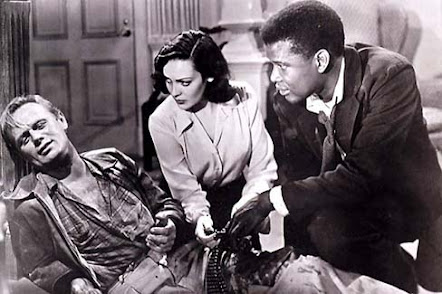No Way Out (1950) is an American film noir directed by Joseph Mankiewicz and starring Richard Widmark, Linda Darnell, Stephen McNally, and in his film debut, Sidney Poitier. The movie was produced by Darryl F. Zanuck with music by Alfred Newman.
The plot concerns Dr. Luther Brooks (Poitier) as the first black doctor to be employed at the urban hospital where he trained. While working at the hospital's prison ward, brothers Johnny and Ray (Widmark) Biddle are brought in to be treated for gunshot wounds they received while attempting a robbery.
Johnny’s symptoms worry Luther, suspecting he may have a brain tumor. While he is trying to tend to Johnny, Ray hurls insults and racial epitaphs at Luther. Still believing that Johnny may be suffering from a brain tumor, Luther performs a spinal tap, but Johnny dies during the procedure. Ray accuses Luther of murdering his brother and vows revenge.
Will Luther be able to survive the suspicion that he may have misdiagnosed Johnny? Will Ray make good on his vendetta against Luther?
Linda Darnell (1923 – 1965) was an American film actress. She signed a contract with 20th Century-Fox at age 15 and became a star almost overnight. She was immediately cast opposite Tyrone Power in Day-Time Wife (1939). She made two films with Power in 1940: Brigham Young and The Mark of Zorro. In 1941, she was again paired with Power in Blood and Sand, which also starred an up-and-coming Rita Hayworth. Darnell’s most famous role was that of Amber St. Clair in Forever Amber (1946), which turned out the be the biggest hit of the year. The role of Amber was the most sought-after female role since the casting of Scarlett O’Hara in Gone with the Wind (1939). Other important films she starred in include Unfaithfully Yours (1948), A Letter to Three Wives (1949), and No Way Out (1950). She died tragically at age 41 in a fire while visiting friends in Glenview, Illinois.
Stephen McNally (1911 - 1994) was an American film, stage, and television actor. He is mostly remembered for his roles in westerns. McNally often played the bad guys like his portrayal of Locky McCormick in Johnny Belinda (1948). McNally earned a law degree from Fordham University Law School. During the 1950s, he started working in television starring in popular series like Wagon Train, Riverboat, Rawhide, 77 Sunset Strip, The Virginian, Fantasy Island, Starsky & Hutch, Charlie’s Angels, The Rockford File, and Police Story.
Sidney Poitier (1927 - 2022) was an American actor and director. He was the first black man to win the Academy Award for Best Actor for his role in Lilies of the Field (1963). Poitier made his film debut in No Way Out which launched him on a path to movie stardom. Other early films include Cry, The Beloved Country (1951), Blackboard Jungle (1955), and Edge of the City (1957). Another breakthrough came with The Defiant Ones (1958) where he co-starred with Tony Curtis. Both actors were nominated for the Best Actor Academy Award, with Poitier’s nomination the first for a black man. In 1959, he starred in the first production of A Raisin in the Sun on Broadway. He starred in the film version in 1961. That same year he starred with Paul Newman and Joanne Woodward in Paris Blues. Other film roles include The Bedford Incident (1965), A Patch of Blue (1965) co-starring Elizabeth Hartman and Shelley Winters. Poitier’s big year was 1967. He had three hits with To Sir, with Love, In the Heat of the Night, and Guess Who’s Coming to Dinner. The popularity of these three films made him the top box office draw of the year. Later in his career, Poitier started directing films like Uptown Saturday Night (1974) and Stir Crazy (1980). Poitier was a recipient of an Honorary Academy Award for his contribution to the motion picture industry.
No Way Out trivia
- Sidney Poitier lied to director Joseph Mankiewicz, telling him he was 27 years old when he was only 22.
- James Edwards, another pioneering black actor, was the first choice to play Luther.
- The film was initially banned by the Chicago Police Department until the scene where the two gangs arm themselves was deleted.
- Linda Darnell was in a serious car accident during filming that almost burned her to death.
- Of the main cast, Linda Darnell was the veteran having starred in her first film in 1939 when she was still in her teens. She was only 27 when No Way Out was released.
Why watch this film?
- To see star-in-the-making Sidney Poitier.
- It’s an early film dealing with the issue of prejudice and racism.
- It’s a chance to see Richard Widmark when he was still playing criminals and low-lives.
- Linda Darnell is featured in a non-glamorous role.
To watch the film on YouTube, click the link below.
Discussion questions:
- How would you compare this film to Odds Against Tomorrow?
- Did you think the situations in this film were realistic?
- What did you think of Sidney Poitier’s big-screen debut?
- Did you have a favorite scene, piece of dialogue, or performance?
- Was Linda Darnell’s character arch believable?
To join the discussion on January 17, 2022, at 6 p.m. Central Time, click here. Once you RSVP, you’ll receive an invitation with a link to the discussion on Zoom.

No comments:
Post a Comment